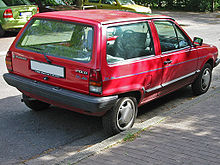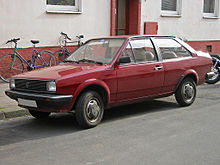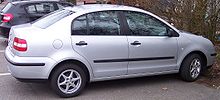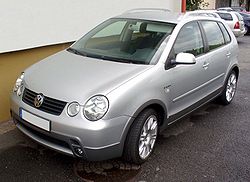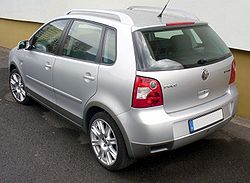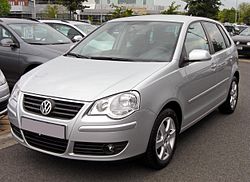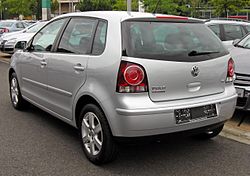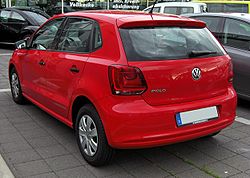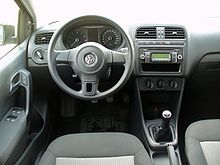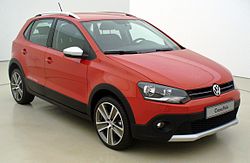- Volkswagen Polo
-
Volkswagen Polo 
Manufacturer Volkswagen Production 1975–present Class Supermini Platform Volkswagen Group A0 platform The Volkswagen Polo is a supermini car (subcompact) manufactured by Volkswagen. It is sold in Europe and other markets worldwide in hatchback, saloon, coupé and estate variants.
The Polo was first introduced in 1975, and as of 2011[update] has been produced in five distinct generations, with additional intervening "facelift" revisions. Related Volkswagen Group models include the Škoda Fabia and SEAT Ibiza.
Contents
History
As of 2009, there have been five separate generations of the Polo, usually identified by a "Series" or "Mark" number.[1]
Some generations were facelifted mid way through production, with the updated versions known unofficially by an addition of the letter F to the mark number, e.g. Mark IIF. Some press and enthusiasts consider the facelifts to be separate models and hence have used the unofficial designations Polo Mark 1 to Mark 7 for previous generations.[2] Each model of Polo is also identified by a two- or three-character Volkswagen Group Typ number. Official VW Polo history describes Mark I to Mark IV using either Roman numerals[1] or Arabic numerals, with facelifted variants known as "Phase II" models.[3]
The body style has been varied through the life of the car, originally as a hatchback which derived from the Audi 50.[2] A saloon version was marketed as the Volkswagen Derby.
Volkswagen vehicles built off different platforms have carried the Polo name plate. For example the Volkswagen Polo Playa hatchback sold in Southern Africa in the late 1990s was a rebadged SEAT Ibiza which has a different body shell from the Mark III Polo sold in Europe at the same time. The current saloon is only available in China, Latin America and South Africa and other Southern Africa countries.
Performance versions and motorsport
Volkswagen helped consolidate the preeminence the so-called hot hatch genre of high performance hatchbacks with their Golf GTI in 1975, and has produced a number of performance versions of the Polo. The first of these was the Polo GT version of the Mark 1F.
The Mark II and IIF were available as supercharged G40 models. The GT G40 with its 1.3-litre 85 kW (115 bhp) could reach 100 km/h (62 mph) in 8.1 s from standstill and had a maximum speed of 196 km/h (122 mph). It was used by Volkswagen to set a number of world endurance speed records, such as the 1.3-litre class records for speed over 24 hours and speed over a distance of 5000 km.
The fastest version of the Mark III on the UK market was the 16-valve h 100 PS (74 kW; 99 hp) model. A 120 PS (88 kW) Polo GTI model was also produced, but only in a limited edition in Germany, and this was the first time the GTI label had been used for a Polo. A GTI version of the Mark IIIF Polo, with a 125 bhp (92 kW) 1.6-litre petrol engine was also produced.
In 2004 Volkswagen Individual, a specialist division of Volkswagen, produced a limited number of (Mark IV Polo) Club Sports with a 1.8T 180 hp/132 kW engine. Available only in Germany, this was based on the one-make racing series Polo Cup Racer hatchback. The Club Sport came with a roll cage inside the vehicle and Recaro racing seats as standard.
A GTI version of the Polo Mark IVF was launched in 2006. This features styling similar to that of the contemporary Golf GTI and a turbocharged 20-valve 150 bhp 1.8-litre petrol engine. It has a 0-60 mph time of 8.2 s and a top speed of 134 mph (216 km/h).
Volkswagen Individual have also engineered an even faster Polo called the Polo GTI Cup Edition. Available with the same 1.8T engine, albeit with 180 bhp (130 kW), its claimed 0–100 km/h (0-62 mph) is 7.5 s and it has a claimed top speed of 225 km/h (140 mph).
Volkswagen Racing in South Africa rallied a four-wheel drive Mark IVF Polo which shared some components with its sister World Rally Championship (WRC) Škoda Fabia; the S2000 has a 2.0 L 191 kW (260 bhp) engine.
Mark IV Polos have been entered into the Junior World Rally Championship (JWRC).
There have been a number of one make race series for the Polo, starting with the Volkswagen Polo G40 Cup for Mark II and Mark IIF G40 versions. The current Polo Cup championship for 105 bhp (78 kW) cars is a support race at rounds of the Deutsche Tourenwagen Masters.
Related models
The first Polo was effectively a rebadged version of the Audi 50 hatchback launched in August 1974.[2] The Audi 50 was discontinued in 1978 as Audi concentrated on larger luxury models. The Mark I and Mark II versions of the Polo were then standalone models in the Volkswagen range.
With the expansion of the Volkswagen Group, Audi (in the 1960s), SEAT (in the 1980s) and Škoda (in the 1990s) were acquired, and the platform used for the Polo was shared with other models.
The Mark III Polo shared its platform with the SEAT Ibiza Mark II. The Ibiza was actually launched before the Polo, and shared essentially all its mechanicals, the dashboard and other interior components, although there were no body panels shared between the two cars. The saloon and estate versions of the Mark III Polo were actually re-badged SEAT Córdoba models, and had no body panels in common with the Polo hatchback. The SEAT Inca and Volkswagen Caddy vans were also based on this model. The Volkswagen Lupo and SEAT Arosa were also based on a shortened version of the Mark III Polo platform.
The Mark IV Polo continued this trend of platform sharing, with the SEAT Ibiza Mark III and Škoda Fabia Marks I & II both being developed on the same platform and featuring several of the same engines.
The 2009 Mark V Polo is developed on the newest platform PQ25, the same platform used in the SEAT Ibiza Mark IV that was launched in 2008 and the Audi A1.
Bodystyles
The first Polos were hatchbacks, with the saloon being marketed as the Volkswagen Derby.
On the arrival of the Mark II model, the saloon was renamed the Volkswagen Polo Classic and the hatchback style was renamed as a coupé, the Volkswagen Polo Coupé. Unusually, the Polo that was marketed as a hatchback was closer in concept to an estate. This version was the most popular in virtually every country where the Polo was sold.
From the Mark III onwards, the range was more straightforwardly conventional, including unambiguous saloon, hatchback and estate models.
Body style summary
- 3-door hatchback (all versions) - the Mark II and Mark IIF were available in two separate 3-door hatchback styles, one of which was badged as a coupé
- 2-door saloon (Mark I, Mark IF, Mark II, Mark IIF)
- 4-door saloon (Mark III, Mark IIIF, Mark IV, Mark IVF, Mark V)
- 5-door hatchback (Mark III, Mark IIIF, Mark IV, Mark IVF, Mark V)
- 5-door estate (Mark III, Mark IIIF)
- 5-door crossover SUV-style (2WD) hatchback (Mark IV, Mark IVF, Mark V)
Mechanical layout
The Polo is a compact car, with a traditional transversely mounted engine and front-wheel drive. Mark I Polos only came with four-cylinder petrol engines, but for the Mark II, a diesel engine was offered for the first time, although only in certain markets, others having to wait until the launch of the Mark III. The current range includes a variety of three- and four-cylinder petrol and diesel engines.
Early versions used four speed manual transmission, whilst the current car is available with either five-speed manual or four-speed automatic transmission. The suspension system on all models uses a fully independent MacPherson strut front suspension, and a Twist-beam rear suspension. Most models use disc brakes at the front and rear drum brakes, although some recent models have all round disc brakes.
Polo Mark I (Typ 86, 1975–1979)
Main article: Volkswagen Polo Mk1Volkswagen Polo Mark I 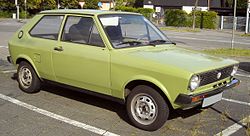

Also called Volkswagen Derby Production 1975–1979 (Mark I)
1979–81 (Mark IF)Body style 3-door hatchback
2-door saloonPlatform Volkswagen Group A01 Related Audi 50
Volkswagen DerbyThe first-generation Polo, a rebadged version of the Audi 50, was introduced in 1975 and was produced until October 1981.[1][4] By 1979, 500,000 Polos were produced worldwide.[1] It shared the internal designation Typ 86 with the Audi 50.
The differences between the Audi and Volkswagen models were minor, with the Polo being cheaper and much more basic. The two cars were initially sold alongside each other, but the Audi 50 never sold as well, and was withdrawn in 1978. The Polo was manufactured at the Volkswagen plant in Wolfsburg.
In 1977, the Derby saloon was released, which was simply a Polo, identical to the hatchback from the C-pillar forward, with a large boot attached (an Audi proposal which was never sold by them)[citation needed].
The Mark I Polo was available with the following engines:
- 895 cc, straight-4 petrol (hatchback only)
- 1093 cc straight-4 petrol, 50 PS (37 kW)
- 1272 cc, straight-4 petrol, (Polo GT, Derby sedan models, Audi 50 only)
Different levels of compression were used on each size to achieve different power outputs, and the variations are numerous, often differing depending on the country of sale, ranging from 35 to 60 PS (26 to 44 kW).
Polo Mark I facelift (1979–1981)
Volkswagen Polo Mark IF 
Production 1979–1981 The Mark I Polo and Derby were facelifted in 1979. Sometimes referred to as the Mark IF, the facelifted model featured plastic bumpers, a different front grille and a revised dashboard. The round headlights of the Derby were replaced with square ones, bringing it into line with the similar (but larger) Golf-based Jetta saloon.
Polo Mark II (Typ 86C, 1981–1990)
Main article: Volkswagen Polo Mk2Volkswagen Polo Mark II (86C) 
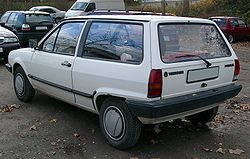
Also called Volkswagen Derby Production 1981–1990 (Mark II)
1990–94 (Mark IIF)Assembly Navarra, Spain
Wolfsburg, GermanyBody style 3-door estate / square back
3-door hatchback
2-door saloon (in many markets branded as 'Derby')Platform Volkswagen Group A02 The Polo Mark II (or Typ 86C) was introduced in October 1981,[1][5] with the major change being the introduction of a third body style with a steep (almost vertical) rear window, in addition to a version resembling the original Mark I shape with a diagonal rear window. These two body styles were called the Wagon (in some markets) and Coupé respectively, although in fact both were three-door hatchbacks, and in some markets the Wagon designation was not used, with that car being simply the "Volkswagen Polo" without a suffix. The sedan version was now called the Polo Classic, and the Derby name became extinct. Production was expanded to Spain in the mid-1980s following Volkswagen's takeover of SEAT. By 1983, the millionth Polo was produced. The second million were produced by 1986.[1]
The model now competed in the supermini sector with the likes of the Austin Metro, Ford Fiesta and Citroën Visa and it was one of the largest models in its class. Due to Volkswagen's sub-premium marketing positioning, however, its pricing was closer to competitor models in the class above, such as the Ford Escort and Vauxhall Astra/Opel Kadett.[citation needed]
The Mark II Polo was used extensively by Volkswagen to develop future innovations, for example supercharging with a 40 mm G-Lader supercharger in the GT G40 version. A 60 mm G-Lader would later be used on the larger and more technically challenging G60 engine used in the Golf and Corrado.
A fuel efficient two-cylinder diesel was prototyped in the mid 1980s with a G40 supercharger to overcome its small capacity, although this did not make it to production. A high fuel efficiency model which did make production was the Formel E (E for Economy), introduced in 1983. This used a high compression 1272 cc engine, overdrive top-gear ratio and an early stop-start ignition system (called "SSA") which would cut the engine when idle for more than two seconds to save fuel whilst temporarily stopped in traffic, and re-start the engine on moving the gear lever to the left in neutral. Similar systems were later used on the Volkswagen Golf Mk3 and various systems from other car manufacturers.
It was a popular import in the UK, competing with the likes of the Peugeot 205, Fiat Uno and Nissan Micra. Its reliability and build quality were among the best to be found on a small car of this era.[citation needed]
The Mark II was available with the following engines:
- 1093 cc straight-4 petrol (1981–1983)
- 1272 cc straight-4 petrol (1981–)
- 1043 cc straight-4 petrol (1983–)
- 1272 cc straight-4 petrol with fuel injection and equipped with a catalytic converter. (1983–) GT
- 1272 cc straight-4 supercharged petrol with 113 PS (83 kW) ( G40 version 1987 only)
- 1.3 L straight-4 diesel (1986–)
- 1.4 L 4straight-4 diesel (1990–)
Polo Mark II Facelift (1990–1994)
Volkswagen Polo Mark IIF 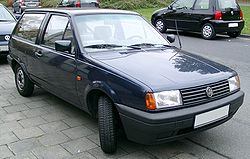
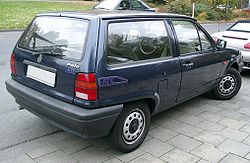
Production 1990–1994 Assembly Navarra, Spain
Wolfsburg, Germany
Zwickau, GermanyThe Mark II Facelift(referred as the Mark IIF, also erroneously known as the "Mark 3") was a far-reaching facelift of the MkII, including a re-skin of the bodywork, The new look saw square headlights, enlarged and reshaped tail-lights, bigger bumpers and a new interior (dashboard and door trim).[6] The three different body styles were maintained. As well as the cosmetic differences, under the skin the car received modifications to the chassis, suspension and brakes. The new Polo still had the 4-cylinder engines but now as well as the carburettor 1.0 L, a fuel injection model was available with single-point injection and all engines came with a catalytic converter as standard to combat tightening European emissions regulations. The saloon was only produced in Spain, and production ceased in 1992.
At the time of launch of the Mark IIF Polo, the highest performance model was the Polo GT. This featured a multi-point fuel injected version of the 1272 cc engine. This produced 75 bhp (56 kW) and had a quoted top speed of 107 mph (172 km/h). 0-60 figures stood at 11.1 seconds. Defining features of the GT include red piping in the bumpers, black overhead cloth, a rev counter and a red "GT" badge in the grille. This was succeeded by the launch of the G40 in May 1991, displacing the GT as the most powerful Polo at the time. The GT squareback was discontinued in 1992 due to poor sales in comparison with the coupé version.[citation needed]
Soon after the launch of the Mark IIF, another sporting model was added to the range — a new version of the supercharged G40, now as a full production model in all markets rather than the limited batch of Mark II G40s. As with the previous model, Volkswagen Motorsport modified G40 Cup cars were sold for racing in a one-make series, the Volkswagen Polo G40 Cup. Features that define the G40 from other Polo models at the time (on top of the GT) include a bee-sting aerial, BBS cross-spoke alloy wheels, Le Mans interior trim and front and rear red "G40" badges.
Polo Mark III (Typ 6N, 1994–1999)
Main article: Volkswagen Polo Mk3Volkswagen Polo Mark III (6N) 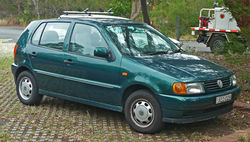
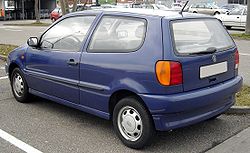
Production 1994–2000 (Mark III) Assembly Navarra, Spain
Martorell, Spain
Wolfsburg, GermanyBody style 3-door hatchback
5-door hatchback
4-door saloon
5-door estatePlatform Volkswagen Group A03 Related SEAT Ibiza Mk2
SEAT Cordoba Mk1
SEAT Inca
VW Caddy
VW Polo ClassicThe Mark III Polo or Typ 6N, (sometimes referred to as the "Mark 4" by enthusiasts as it is the Polo's fourth guise) appeared in 1994,[1][7] and was a completely new model (on a new chassis), available as 3- and 5-door hatchback versions. It shared its platform with the SEAT Ibiza Mark 2. This platform actually used the floorpan of the Volkswagen Golf Mk3 (a multitude of mechanical parts and all of the suspension components were interchangeable among the three models). Although the dashboard and a number of mechanical components, including engines, were shared with the Ibiza, outwardly the two cars were different, with no shared body panels.
The saloon and estate versions of the Mark III were essentially rebadged SEAT Córdobas, which were launched a year earlier. They were referred to internally by Volkswagen as the Typ 6KV, and shared body panels with the SEAT model rather than the Polo hatchback models, with some cosmetic alterations such as new rear and front bumpers and headlights. The Volkswagen Caddy 9K van also shares the same platform and front-end styling as the 6KV models.
The Volkswagen Lupo and SEAT Arosa city cars were based on a shortened version of the Typ 6N platform, and shared many components.
The car was available with the following engines:
- 1043 cc straight-4 petrol 45 PS (33 kW; 44 hp) (1995–97)
- 1272 cc straight-4 petrol 55 PS (40 kW; 54 hp) (1995–96)
- 1.6 L straight-4 petrol 75 PS (55 kW; 74 hp)
- 1.4 L straight-4 16 valve petrol 100 PS (74 kW; 99 hp) (Engine Code - AFH)
- 1.4 L straight-4 petrol 60 PS (44 kW; 59 hp)(1996–)
- 999 cc straight-4 petrol 50 PS (37 kW; 49 hp) — all-new aluminium block multi-point injection (1997–)
- 1.6 L straight-4 16 valve petrol 120 PS (88 kW; 120 hp) (LHD European GTI model only)
- 1.6 L straight-4 petrol 100 PS (74 kW; 99 hp) (6K saloon and estate models only)
- 1.6 L straight-4 petrol 75 PS (55 kW; 74 hp) (6K saloon and estate models only)
- 1.9 L straight-4 diesel 64 PS (47 kW; 63 hp)
Polo Mark III Facelift (Typ 6N2, 2000–2002)
Volkswagen Polo Mark IIIF (6N2) 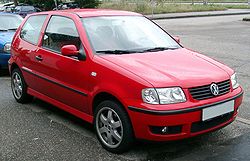
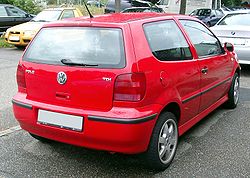
Production 2000–2002 (Mark IIIF) Assembly Navarra, Spain
Martorell, Spain
Bratislava, SlovakiaBody style 3-door hatchback
5-door hatchback
4-door saloonPlatform Volkswagen Group A03 Related SEAT Ibiza Mk2
SEAT Cordoba Mk1
SEAT Inca
VW Caddy
VW Polo ClassicThe facelifted Mark III Phase II[3] (or Typ 6N2; sometimes referred to as the Mark IIIF or "Mark 5" by enthusiasts) was released in 2000.[1][8] The hatchback models featured updated styling including new headlights and bumpers and an all new interior based on that of the Lupo. Although the car was similar in appearance to the Mark III, Volkswagen claimed that 70% of the components were new. The bodyshell was fully galvanised and stiffened but not fully redesigned, although some panels were changed. Twin airbags were made standard. The saloon and estate versions received the new interior, but not the full exterior facelift. Also, the 3-cylinder 1.4 TDI engine was introduced for the 3 and 5-door hatchbacks as well as a 1.6 16v GTI version. The Mark IIIF Polo Classic is still sold in Mexico and Argentina. In Mexico is known as the Derby.
Both versions of the Mark III Polo were strong sellers in the UK, never quite a match for market leaders such as the Ford Fiesta and Vauxhall Corsa[citation needed], but a strong competitor for the likes of the Fiat Punto and Nissan Micra. At the time of its launch, it was arguably the best small car on sale in Britain in terms of build quality and "upmarket" feel, something that was noticeably absent from the likes of the Citroën Saxo and Peugeot 106. By the time of the Mark III's demise however, many of its competitors had matched and even exceeded its standards[citation needed]. The 1.4 TDI was considered the best in the range due to its reliability, fuel consumption, and relative power, for a small engine.
Awards
- 1999 Used Car Buyer "Greatest Used Car Buy Awards" – Best Economy Car
- 1998 Top Gear Magazine "Top Cars" – Best Supermini
- 1997 Auto Express "New Car Honours" – Best Supermini
- 1997 "Complete Car of the Year Awards" – Best Supermini
- 1995 Which? Magazine "Best Buys" – Best Supermini
- 1996 Semperit Irish Car of the Year
- 1995 What Car? – Car of the Year
Polo Playa (1996–2002)
Main article: Volkswagen Polo PlayaThe Volkswagen Polo Playa was a model for the South African market. It was sold instead of the European Polo Mark III from 1996 until 2002, and was effectively a rebadged SEAT Ibiza Mark II. In 2002, the Mark IV Polo was adopted in South Africa, and the separate Polo Playa model was dropped.
Polo Mark IV (Typ 9N, 2002–2005)
Main article: Volkswagen Polo Mk4Volkswagen Polo Mark IV (9N) and Mark IVF (9N3) 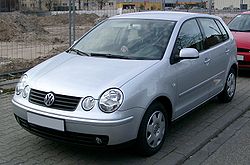

Production 2002–2005 (Mark IV) Assembly Navarra, Spain
Bratislava, Slovakia
Anchieta, Brazil
Uitenhage, South Africa
Mexico
Brussels, Belgium
Luanda, Angola (VW/Ancar)Body style 3-door hatchback
5-door hatchback
4-door saloonPlatform Volkswagen Group PQ24 Related SEAT Ibiza Mk3
SEAT Cordoba Mk2
Škoda Fabia Mk1
Škoda Fabia Mk2
Volkswagen FoxUnveiled in September 2001, the all-new Mark IV (or Typ 9N, sometimes erroneously referred to as the "Mark 6") model was put on sale in early 2002.[1] It shares its platform with the SEAT Ibiza Mk3 , Škoda Fabia Mk1 and Škoda Fabia Mk2. The car is all new compared to the Mark III/F, and bears more structural resemblance to the Typ 6KV than the Typ 6N; outwardly the most recognisable change is the use of quad round headlights similar to the Lupo's.
The car was available with the following engines:
- 1.2 L straight-3 6-valve petrol, 55 PS (40 kW)
- 1.2 L straight-3 12-valve petrol, 65 PS (47 kW)
- 1.4 L straight-4 16-valve petrol, 75 PS (55 kW)
- 1.4 L straight-4 16-valve petrol Fuel Stratified Injection, 86 PS (62 kW) (FSI-badged model)
- 1.4 L straight-4 16-valve petrol, 100 PS (74 kW) (16V-badged model).
- 1.4 L straight-3 TDI, 75 PS (55 kW).
- 1.9 L straight-4 SDI, 64 PS (47 kW)
- 1.9 L straight-4 TDI PD, 100 PS (74 kW)
- 1.9 L straight-4 TDI PD, 130 PS (96 kW) (GT model only).
- 1.6 L straight-4, 8 valve petrol, 101 PS (74 kW; 100 hp), cast iron block, very short manual gearbox (Brazilian / South African market)
- 2.0 L straight-4, 8 valve petrol, 115 PS (85 kW; 113 hp), cast iron block, very short manual gearbox (Brazilian / South African market)
Dimensions:
- Length: 3897 mm
- Width: 1650 mm
- Height: 1465 mm
- Wheelbase: 2460 mm
Volkswagen Racing rallyed a Polo S1600 in the 2003 Junior World Rally Championships, winning the Turkish round. The Super 1600 developed 165 kW/215 to its front wheels.
This version of the Polo was a mixed success in the UK. It sold reasonably well (though not as well as some earlier Polos) but several customer satisfaction surveys by high profile motoring magazines such as Top Gear gave the Polo a very low rating. Top Gear's 2005 survey rated the Polo as the third least satisfying supermini to own, with only the Fiat Punto and Rover 25 receiving a worse rating. It fell behind most of its crucial rivals, namely the Ford Fiesta, Vauxhall Corsa, Citroën C3 and Peugeot 206.
A saloon version, called Polo Classic, was produced in Brazil, South Africa and China, and exported to the rest of Latin America and to Australia.
The Polo Classic for the Australian market is sourced from China, making it the first Chinese built car to be exported to a right hand drive country.[9]
Polo Fun / Polo Dune / Polo Soho
Volkswagen Polo Fun
There was also a crossover SUV version of the Polo, similar to the Rover Streetwise, with "off-road" styling, named Polo Fun (Polo Dune in the UK, Polo Soho in Spain), but despite its appearance the car was never available with 4motion four-wheel drive.
Polo Mark IV Facelift (Typ 9N3, 2005–2009)
Volkswagen Polo Mark IV Facelift
Production 2005-2009 In 2005, the Mark IV was face-lifted with new Volkswagen Passat-style one piece headlights and tail lights, and a different hatch. This facelifted model is officially known as the Mark IV Phase II[3] or Typ 9N3, and sometimes erroneously to as the Mark IVF or "Mark 7". Designed by Walter de'Silva, in the UK, the Mark IVF is available in seven different trim levels, ranging from the basic Polo E model to the Polo GTI. The engine range is as for the Mark IV, with the addition of the following engines:
- 1598 cc, straight-4, 16-valve petrol, 77 kW (105 PS; 103 hp)
- 1598 cc, straight-4, 8 valve flexfuel, 101 PS (petrol) / 103 PS (ethanol), cast iron block, very short manual gearbox (Brazilian market)
- 1781 cc, turbocharged straight-4, 20V petrol, 150 PS 150 PS (110 kW; 148 hp) (Polo GTI models only) - special GTI Cup Edition with 180 PS (132 kW; 178 hp)
- 1422 cc, straight-3, 70 and 80 PS (51 and 59 kW) TDI
- 1896 cc, straight-4, 100 and 130 PS (74 and 96 kW) TDI
- 1984 cc, straight-4, 8 valve petrol, 116 PS (85 kW) (South African and Brazilian market)(very short manual gearbox in Brazilian market)
Dimension:
- Length: 3,926 mm (154.6 in)
- Width: 1,650 mm (65.0 in)
- Height: 1,465 mm (57.7 in)
- Wheelbase: 2,460 mm (96.9 in)
Polo Vivo
Volkswagen Polo Vivo 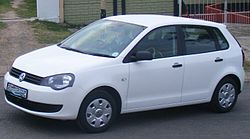
Production 2010-present On 11 March 2010, Volkswagen South Africa announced that the Volkswagen Citi Golf is being replaced by a version of the Mk 4 Polo, the Polo Vivo. It is available with a choice of two 1.4 engines (55 kW & 63 kW)[10] and a 1.6 engine (77 kW).[11] The Polo Vivo is released in both 3-door and 5-door versions, or as a saloon.
In comparison to the Polo Mk4, the Polo Vivo has a restyled front bumper and grille, deleted scuff strips on the bumpers and sides of the car, and side indicators relocated from the wing mirrors to the front fenders. This restyling gives the Polo Vivo some of the elements of the design language used in other contemporary VW models.
The interior of the Polo Vivo is very close to that of the Mk4 Polo, most obvious differences are:[citation needed]
- No pop out cup holder in the dash.
- No console lighting adjustment.
- No roof mounted hand holds.
- New AUX port and cup holder in the front centre console.
- No clips to hold down floor mats.
- Addition of Hazard warning triangle in the boot.
- Different tool holder for jack and wheel spanner.
- Central locking moved from door to center console
The Polo Vivo, manufactured at VW's Uitenhage plant in South Africa sources 70%[12] of the Vivo parts locally.
CrossPolo
Volkswagen CrossPolo 
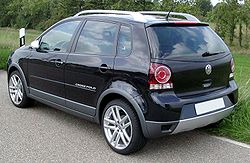
A mini SUV-styled (but still two wheel drive) CrossPolo version of the Mark IVF was also produced as a successor to the Polo Fun.
Polo BlueMotion
In 2007, Volkswagen premiered its BlueMotion range with the emphasis of lower emissions and high fuel economy. Volkswagen's first car under the BlueMotion range is a modified 1.4 litre VW Polo TDI with longer gear ratios, aerodynamic changes and lightweight alloys with low rolling resistant tyres. The end result is a car capable of producing less than 100g/km of CO2 with a stated fuel economy of 74.3mpg on a combined cycle. Volkswagen plans to use the platform set by the Polo on expanding their BlueMotion ranges which includes the Volkswagen Golf and the Volkswagen Passat.
Polo Mark V (Typ 6R, 2009–present)
Main article: Volkswagen Polo Mk5Volkswagen Polo Mark V
Production 2009–present (Mark V) Assembly Navarra, Spain
Chakan, India[13]
Uitenhage, South Africa[14]
Kaluga, Russia[15]Body style 3-door hatchback
4-door sedan[15]
5-door hatchbackPlatform Volkswagen Group PQ25 Related SEAT Ibiza Mk4
Audi A1Volkswagen launched the fifth generation Polo (internal designation Typ 6R) at the Geneva Motor Show in March 2009. For the first time in Polo's history, the car was declared European Car of the Year, for 2010.[16] The Polo was also declared 2010 World Car of the Year at the New York International Auto Show in April 2010.[17] It also won What Car? 2010 Supermini Car of the Year as well as being awarded *Japan Import Car of the Year for 2010-2011.[citation needed]
It shares its platform with the 2008 SEAT Ibiza Mk4 and the Audi A1. Production for the UK market started in summer 2009, with first deliveries in October 2009.[18] Official images released show the new Polo follows styling cues from the Golf VI.[19]
The Polo Mark V is 36 mm longer and 32 mm wider and sits 13 mm lower to the road than the previous generation Polo. Boot capacity is increased by 10 litres to 280 litres of storage space with 952 litres with the seats folded down. The car is 7.5% lighter than its predecessor. The Polo has thorax airbags and has been awarded a five-star Euro NCAP crash impact rating.[20] Engines are quoted as:
- 1.2 L, 3 cylinder petrol, 60 PS (44 kW; 59 hp) or 70 PS (51 kW; 69 hp); efficiency: 5.5L/100 km (claimed)
- 1.2 L TSI, turbocharged 4 cylinder petrol, 105 PS (77 kW; 104 hp)
- 1.4 L, 4 cylinder petrol, 85 PS (63 kW; 84 hp); efficiency: 5.9 L/100 km (claimed) - Suitable for low grade petrol, optional 7-speed DSG
- 1.6 L, 4 cylinder petrol, 105 PS (77 kW; 104 hp); efficiency: 6.4 L/100 km (claimed) - Suitable for low grade petrol, optional 6-speed DSG (South African Market)
- 1.6 L TDI, turbocharged 4 cylinder common rail diesel, 75 PS (55 kW; 74 hp); efficiency: 4.2L/100 km (claimed), 109 g/km of CO2
- 1.2 L TDI, turbocharged 3 cylinder common rail diesel, 75 PS (55 kW; 74 hp); efficiency: 3.4L/100 km (claimed), 89 g/km of CO2 (BlueMotion)
- 1.6 L TDI, turbocharged 4 cylinder common rail diesel, 90 PS (66 kW; 89 hp)
- 1.6 L TDI, turbocharged 4 cylinder common rail diesel, 105 PS (77 kW; 104 hp); efficiency: 4.2L/100 km (claimed), 109 g/km of CO2
GTI (1.4 L TSI 180 PS (130 kW; 180 hp) with DSG) and BlueMotion (with 1.2 L TDI 3 cylinder engine with 75 bhp) versions of the Polo have also been released. The next generation Polo will also become available in North America, as Volkswagen is looking to add a subcompact vehicle to its lineup there.[21]
Sales in the UK
In 2010, its first full year on sale in the United Kingdom, more than 45,000 units were sold. It was the UK's sixth best selling new car.[22] This was a record for Polo sales in the UK; never before in more than 30 years on sale in the UK had any version of the Polo managed to finish among the top ten best selling cars.[citation needed]
Polo Sedan (Russia)/Vento (India)
A sedan version of the Polo Mark V was launched in India and Russia in 2010 as the Volkswagen Vento and Polo Sedan.[23][24] It has a length of 4.384m, increased wheelbase (2.552m) and ground clearance (168-170mm), and has one petrol (1.6 L, 4 cylinder, 105 PS; coupled with either 5-speed manual or 6-speed automatic gearbox) and one diesel engine (1.6 L, turbocharged 4 cylinder common rail, 105 PS; only 5-speed manual gearbox) options available. As of May 2011, Polo Sedan (Russia) is currently manufactured only with petrol engine.
CrossPolo
Volkswagen CrossPolo
In June 2010, Volkswagen presented the 2011 edition of the CrossPolo, the fourth member of the small car's family. The 2011 edition will be available in petrol and three diesel engines, all Euro 5 compliant.[25]
Currently South Africa has 2 versions available:
One petrol and one diesel in 5-speed Manual
- 1.6 L, 4 cylinder petrol, 105 PS (77 kW; 104 hp)
- 1.6 L TDI, turbocharged 4 cylinder common rail diesel, 105 PS (77 kW; 104 hp)
Fuel economy
Fuel consumption for the South African Polo Classic model[clarification needed]:[26]
Fuel economy
(L/100 km / Imperial mpg)Model Extra-Urban Urban Combined 1.4 diesel 4.7 L/100 km (50.0 mpg-US) 8.5 L/100 km (27.7 mpg-US) 1.4 petrol 6.5 L/100 km (36.2 mpg-US) 11.0 L/100 km (21.4 mpg-US) 1.4 petrol manual 5.3 L/100 km (44.4 mpg-US) 9.2 L/100 km (25.6 mpg-US) 6.9 L/100 km (34.1 mpg-US) 1.6 petrol manual 5.3 L/100 km (44.4 mpg-US) 9.2 L/100 km (25.6 mpg-US) 7.0 L/100 km (33.6 mpg-US) 1.6 petrol auto 5.9 L/100 km (39.9 mpg-US) 10.0 L/100 km (23.5 mpg-US) 7.4 L/100 km (31.8 mpg-US) 2.0 petrol manual 5.9 L/100 km (39.9 mpg-US) 10.4 L/100 km (22.6 mpg-US) 7.6 L/100 km (30.9 mpg-US) 1.9 turbodiesel 74 kW 4.0 L/100 km (58.8 mpg-US) 6.4 L/100 km (36.8 mpg-US) 4.9 L/100 km (48.0 mpg-US) 1.9 turbodiesel 96 kW 4.3 L/100 km (54.7 mpg-US) 6.8 L/100 km (34.6 mpg-US) 5.2 L/100 km (45.2 mpg-US) References
- ^ a b c d e f g h i "Vw: polo history". Archived from the original on 2007-06-08. http://web.archive.org/web/20070608171124/http://media.vw.com/article_display.cfm?article_id=9381. Retrieved 2008-10-16.
- ^ a b c "VW Polo History". http://www.vwpoloshow.co.uk/historyframes2.htm. Retrieved 2008-10-16.
- ^ a b c "Volkswagen UK: Used car locator". Volkswagen.co.uk. http://www.volkswagen.co.uk/used/search. Retrieved 2010-12-17.
- ^ "Polo Mark I". http://www.vwpoloshow.co.uk/history/mk1.htm. Retrieved 2008-10-16.
- ^ "Polo Mark II". http://www.vwpoloshow.co.uk/history/mk2.htm. Retrieved 2008-10-16.
- ^ "Polo Register Volkswagen Polo History 1990 - 94". vwpoloshow.co.uk. http://www.vwpoloshow.co.uk/history/mk2f.htm. Retrieved 2010-09-10.
- ^ "Polo Mark III". http://www.vwpoloshow.co.uk/history/mk3.htm. Retrieved 2008-10-16.
- ^ "Polo Mark IIIF". http://www.vwpoloshow.co.uk/history/mk3f.htm. Retrieved 2008-10-16.
- ^ Volkswagen Polo Classic sedan The Australian, 23 February 2005
- ^ VWSA. "Polo Vivo Specifications". vw.co.za. http://www.vw.co.za/models/polovivo/specs/. Retrieved 2010-09-10.
- ^ Irma Venter. "VWSA launches Polo Vivo as CitiGolf replacement". Engineeringnews.co.za. http://www.engineeringnews.co.za/article/vwsa-launches-polo-vivo-as-citigolf-replacement-2010-03-11. Retrieved 2010-09-10.
- ^ CAR Magazine (2010-03-10). "Volkswagen's budget offering emerges". carmag.co.za. http://www.carmag.co.za/article/volkswagen-polo-vivo-2010-03-10. Retrieved 2010-09-10.
- ^ 4 Feb, 2010, 12.21AM IST, Chanchal Pal Chauhan,ET Bureau (2010-02-04). "VW to make India low-cost export hub - The Economic Times". Economictimes.indiatimes.com. http://economictimes.indiatimes.com/news/news-by-industry/auto/automobiles/VW-to-make-India-low-cost-export-hub/articleshow/5532562.cms. Retrieved 2010-09-10.
- ^ "Volkswagen Polo". Theage.drive.com.au. http://theage.drive.com.au/motor-news/volkswagen-backs-polo-quality-20100709-102rw.html. Retrieved 2010-09-10.
- ^ a b "Volkswagen Rus". Volkswagen.ru. 2010-10-26. http://www.volkswagen.ru/ru/ru/models/polo_sedan.html. Retrieved 2010-12-17.
- ^ VW Polo is European Car of the Year 2010, Daily Telegraph, 30 Nov 2009
- ^ 2010 World Car of the Year, World Car Awards, 1 Apr 2010
- ^ "Volkswagen News: Smarter, lighter and even cleaner: fifth generation Polo unveiled". www.volkswagen.co.uk. 2009-03. http://www.volkswagen.co.uk/volkswagen-world/news/item/131. Retrieved 2009-03-09.
- ^ "The new Volkswagen Polo". http://www.ausmotive.com/2009/03/03/the-new-volkswagen-polo.html. Retrieved 2009-03-03.
- ^ "Volkswagen Polo gets three doors and five stars". http://www.ausmotive.com/2009/08/27/volkswagen-polo-three-door.html. Retrieved 2009-08-27.
- ^ "CONFIRMED: VW Polo coming to the U.S.". http://www.autoblog.com/2009/01/16/confirmed-vw-polo-coming-to-the-u-s/. Retrieved 2009-01-16.
- ^ UK 2010 car sales analysis: winners and losers
- ^ bsmotoring.com. "Volkswagen Vento review - Ventastic!". Bsmotoring.com. http://www.bsmotoring.com/storypage.php?autono=2427. Retrieved 2010-12-17.
- ^ http://www.volkswagen.ru/ru/ru/models/polo_sedan.html
- ^ "2011 Volkswagen CrossPolo". http://www.motorward.com/2010/06/2011-volkswagen-crosspolo/. Retrieved 2010-06-14.
- ^ "Polo Classic Specifications - Volkswagen South Africa". Vw.co.za. http://www.vw.co.za/models/poloclassic/specs/. Retrieved 2010-12-17.
External links
Volkswagen Passenger Cars timeline, European market, 1950–1979 — a marque of the Volkswagen Group — next » type /
class1950s 1960s 1970s 0 1 2 3 4 5 6 7 8 9 0 1 2 3 4 5 6 7 8 9 0 1 2 3 4 5 6 7 8 9 economy car . . . Beetle (Type 1) . . . supermini Polo Mk1 . . . Derby Mk1 . . . small family car Type 3 Golf Mk1 . . . large
family carType 4 K70 (NSU) Passat Mk1 . . . coupé Karmann Ghia Scirocco I . . . Type 34 Karmann Ghia VW-Porsche 914 utility vehicle Type 181 Kurierwagen/Trekker . . . founder: Deutsche Arbeitsfront • Volkswagen corporate website • A marque of the Volkswagen Group « previous — Volkswagen Passenger Cars timeline, European market, 1980s–present — a marque of the Volkswagen Group type /
class1980s 1990s 2000s 2010s 0 1 2 3 4 5 6 7 8 9 0 1 2 3 4 5 6 7 8 9 0 1 2 3 4 5 6 7 8 9 0 1 city car Lupo Fox supermini ... Polo/Derby I Polo/Derby/Classic II Polo/Classic IIF Polo/Classic III Polo IIIF Polo IV Polo IVF Polo V small
family car... Golf I Golf II Golf III Golf IV Golf V Golf VI ... Jetta I Jetta II Vento Bora Jetta V Jetta VI New Beetle large family car Passat I Passat II / Santana Passat III Passat IV Passat V Passat VI Passat VII exec. luxury car Phaeton coupé ... Scirocco I Scirocco II Scirocco III Corrado Passat CC convertible . . . Golf I Cabriolet Golf III Cabriolet New Beetle Cabriolet Eos compact
MPVGolf Plus Touran Touran II large MPV Sharan Sharan II off-roader
(SUV)Tiguan Touareg Touareg II Founder: Deutsche Arbeitsfront • A marque of the Volkswagen Group • 4motion • G40 / G60 Volkswagen Passenger Cars timeline, South American market, 1980–present — a marque of the Volkswagen Group type /
class1980s 1990s 2000s 2010s 0 1 2 3 4 5 6 7 8 9 0 1 2 3 4 5 6 7 8 9 0 1 2 3 4 5 6 7 8 9 0 economy
carGol / Parati (I) Gol / Parati (IF) Gol / Parati (II) Gol / Parati / Gol Country (III) Gol / Parati / Gol Country (IV) Gol (V) Voyage / Gacel (I) Amazon / Senda (IF) Polo Classic (Mk3) Voyage (V) supermini Fox / CrossFox SpaceFox / Suran Polo (Mk4) Polo (Mk4F) small
family carPointer Golf Mk3 Golf Mk4 Apollo Logus Bora Vento / Jetta (Mk5) large
family carPassat (B1) Passat (B3) Passat (B4) Passat (B5) Santana / Corsar / Carat / Quantum car-derived van Caddy III pickup truck Saveiro (I) Saveiro (IF) Saveiro (II) Saveiro (III) Saveiro (IV) Saveiro (V) panel van Volkswagen Transporter founder: Deutsche Arbeitsfront • A marque of the Volkswagen Group • 4motion • Volkswagen do Brasil TC 2000 Championship Seasons Current cars (2011) Chevrolet Cruze • Fiat Bravo • Honda Civic Si • Toyota Corolla • Renault Fluence • Volkswagen Golf • Volkswagen Polo • Ford Focus • Peugeot 307Current circuits Córdoba • General Roca • Oberá • Jorge Ángel Pena • Río Hondo • Resistencia • Santa Fe • Buenos Aires • Centenario • Punta del Este (Uruguay) • Eduardo Copello • San LuisFormer circuits Bahía Blanca • Comodoro Rivadavia • Güemes • Curitiba (Brazil) • Interlagos (Brazil) • Paraná • ViedmaCategories:- Volkswagen vehicles
- Euro NCAP superminis
- Front wheel drive vehicles
- Hatchbacks
- Coupes
- Station wagons
- 1970s automobiles
- 1980s automobiles
- 1990s automobiles
- 2000s automobiles
Wikimedia Foundation. 2010.

